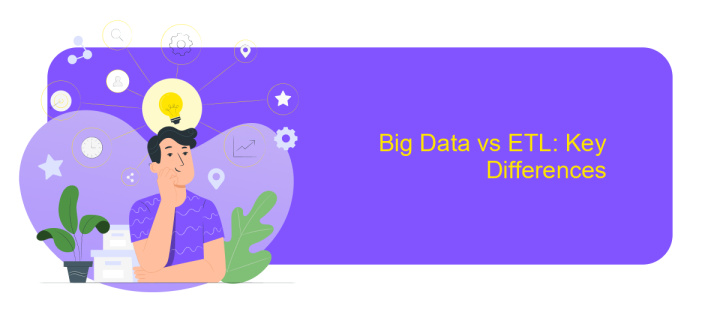Big Data vs ETL
In today's data-driven world, the terms "Big Data" and "ETL" (Extract, Transform, Load) are frequently mentioned, often in the same breath. While both are essential to modern data management and analytics, they serve distinct roles and purposes. This article delves into the differences and synergies between Big Data and ETL, helping you understand how they can be leveraged for optimal data processing and insights.
Introduction
In today's data-driven world, organizations are constantly seeking efficient ways to manage and analyze vast amounts of information. Big Data and ETL (Extract, Transform, Load) are two fundamental concepts that play crucial roles in this process. Understanding the differences and synergies between these technologies can help businesses make informed decisions about their data strategies.
- Big Data: Refers to the large volumes of data generated at high velocity from various sources.
- ETL: A process that involves extracting data from different sources, transforming it into a suitable format, and loading it into a storage system.
- Integration Tools: Services like ApiX-Drive can streamline the integration process, making it easier to connect various data sources and automate workflows.
While Big Data focuses on handling and analyzing massive datasets, ETL is essential for preparing and organizing data for analysis. By leveraging tools such as ApiX-Drive, organizations can enhance their data integration capabilities, ensuring seamless data flow and more effective decision-making. This synergy between Big Data and ETL ultimately empowers businesses to harness the full potential of their data assets.
What is Big Data?

Big Data refers to the vast volumes of structured and unstructured data generated at high velocity from various sources like social media, sensors, transactions, and more. This data is so large and complex that traditional data processing tools cannot handle it efficiently. Big Data encompasses three primary characteristics known as the three Vs: Volume, Velocity, and Variety. Volume refers to the enormous amount of data, Velocity indicates the speed at which data is generated and processed, and Variety signifies the different types of data such as text, images, and videos.
Organizations leverage Big Data to gain insights, improve decision-making, and enhance business processes. Advanced analytics, machine learning, and artificial intelligence are often applied to Big Data to uncover patterns, trends, and correlations. Managing and integrating this data can be challenging, but services like ApiX-Drive simplify the process by automating data integration between various applications and platforms. This enables businesses to seamlessly collect, process, and analyze data, making it a crucial component in the era of digital transformation.
What is ETL?

ETL stands for Extract, Transform, Load, a process used in data warehousing and data integration. It involves extracting data from various sources, transforming it into a suitable format, and loading it into a target database or data warehouse. This process is crucial for consolidating data from disparate sources to provide a unified view for analysis and reporting.
- Extract: Data is collected from multiple sources such as databases, APIs, and flat files.
- Transform: The extracted data is cleaned, validated, and converted into a consistent format.
- Load: The transformed data is loaded into a target system like a data warehouse or database.
ETL tools and services, such as ApiX-Drive, simplify the integration process by automating data extraction, transformation, and loading. These tools enable organizations to efficiently manage data workflows and ensure data integrity across various systems. By streamlining ETL processes, businesses can focus on deriving actionable insights from their data rather than dealing with the complexities of data integration.
Big Data vs ETL: Key Differences

Big Data and ETL (Extract, Transform, Load) are essential concepts in data management but serve different purposes. Big Data refers to vast volumes of structured and unstructured data that require advanced tools and techniques for storage, processing, and analysis. ETL, on the other hand, is a process that involves extracting data from various sources, transforming it into a suitable format, and loading it into a target database or data warehouse.
While both Big Data and ETL aim to make data more accessible and useful, they differ significantly in their approaches and applications. Big Data focuses on handling massive datasets and leveraging technologies like Hadoop and Spark for real-time analytics. ETL is more concerned with data integration, ensuring data consistency, and preparing data for analysis.
- Big Data handles large-scale data processing and real-time analytics.
- ETL focuses on data extraction, transformation, and loading into databases.
- Big Data uses technologies like Hadoop, Spark, and NoSQL databases.
- ETL uses tools like Informatica, Talend, and ApiX-Drive for data integration.
Understanding the key differences between Big Data and ETL helps organizations choose the right approach for their data management needs. While Big Data excels in processing and analyzing large datasets, ETL ensures that data is clean, consistent, and ready for use in business intelligence and reporting.
Conclusion
In conclusion, both Big Data and ETL play crucial roles in modern data management and analytics. Big Data provides the capability to handle vast amounts of diverse data at high velocity, enabling organizations to gain deeper insights and make more informed decisions. On the other hand, ETL processes are essential for transforming raw data into a structured format that can be easily analyzed, ensuring data quality and consistency.
For businesses looking to optimize their data integration workflows, services like ApiX-Drive offer valuable solutions. ApiX-Drive simplifies the process of connecting various data sources and automating ETL tasks, allowing organizations to focus more on data analysis and less on data preparation. By leveraging such tools, companies can enhance their data strategies, improve operational efficiency, and stay competitive in an increasingly data-driven world.
FAQ
What is the primary difference between Big Data and ETL?
Can ETL processes handle Big Data?
How do Big Data technologies integrate with ETL processes?
What are the challenges of using ETL with Big Data?
How can automation tools help in managing ETL processes for Big Data?
Apix-Drive is a universal tool that will quickly streamline any workflow, freeing you from routine and possible financial losses. Try ApiX-Drive in action and see how useful it is for you personally. In the meantime, when you are setting up connections between systems, think about where you are investing your free time, because now you will have much more of it.

